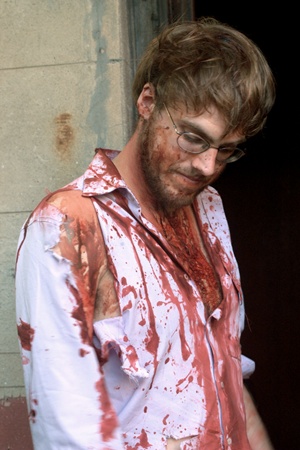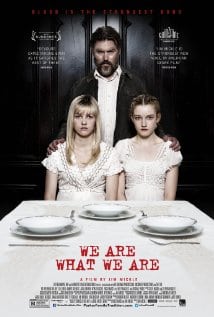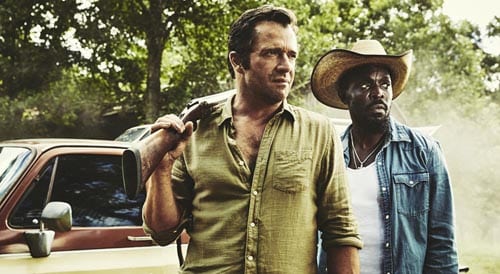INTERVIEW WITH JIM MICKLE, WRITER / DIRECTOR OF STAKE LAND AND MULBERRY STREET

Stake Land is your second collaboration with co-writer and actor Nick Damici, with whom you co-wrote the acclaimed rat-zombie film Mulberry Street. How and why did you and Nick ultimately decide to collaborate for the second time on Stake Land?
Nick and I have been friends for almost 10 years, and there’s a certain creative energy that kicks in once we dig into an idea and get rolling. It’s creates a synergy that really defines both films and their personalities. As a writer he has an amazing way with giving things a heavy, iconic feel, but always with a heart. The fact that we’re from two different generations, means there’s decades of influences that get stirred into these stories. As an actor he’s a lot of fun to work with because he gets so involved. For Stake Land he made his own costume, carved his own weapons, and slept in a tent for the whole shoot. A lot of creating the Mister character for me was just observing how he was off the set. It’s a wonderful experience to make films with friends.
Stake Land marks Kelly McGillis’ return to the big screen after almost a decade and also a significant feature film role for Connor Paolo. Talk a little bit about your decision to cast Kelly and Connor and their subsequent contributions to the film.
Kelly McGillis was a no-brainer and the only real decision was whether we should waste a few days making an offer to her. We had limited time to cast that part, and I remember thinking she was too much of a longshot, and had no reason to return to the bigscreen on an independent horror film. Fortunately she follows her own beats and instincts and doesn’t seem concerned with doing what others expect, and she signed on at the last possible hour for us. Once she joined the film, we knew we were doing something special.
I knew of Connor only from his role in “Snow Angels” and my first reaction was apprehension because of “Gossip Girl”. I’m not a fan of the horror movie trend to cast good looking, young TV stars and though I knew he was a good actor, my own snobbery made it difficult to cast him immediately. Fortunately the casting director Sig de Miguel lobbied endlessly for him, and the best decision I made was to forget my gut reaction and make him “Martin”. I was lucky to find out that the reality is Connor is one of the most gifted actors of his generation. On top of that he adds a focus and dedication that can be startling at times. Many of the best moments in the film came from his ideas and his insane knowledge of his own character arc, and when someone like that is the lead, it makes the director’s job a lot easier. I wanted to follow these characters like we had stumbled across them in the wild and decided to do a travelogue with them, so through spending a lot of time together, Nick and Connor became Mister and Martin before we even shot.
The film obviously owes a lot to the vampire and zombie movie genres as well as apocalyptic movies but there is also a lot of similarities between Stake Land and classical westerns. Was it a conscious decision to make a film that looks and feels like a western?
Very much so. Nick and I adore the western genre, and part of Stake Land comes from the fact that it’s difficult to pull off a pure western these days. We obviously are fans of apocalyptic stories, and found that the two genres fit and complement each other quite well. The idea was to play the future not as a high tech sci-fi vision, but as a look back to the depression and even to the pioneer days as the landscape gets bleaker and more unforgiving. From the cinematography and production design to the costumes, we tried to imagine the film as a depression era world.
Over the last couple of years, the popularity of the vampire genre has exploded throughout film, television, and the literary world. How do you think Stake Land fits into the vampire genre landscape?
By not really being a vampire movie. From day one, our priority was the characters and what they meant to each other. By that thinking, the vampires became another obstacle in a world that had turned cold and brutal. Though they’re nasty and feral creatures, we also tried to treat them like victims in some way. We liked the idea that the fear of these things could be used to control and manipulate. They’re more like terrorists than anything else. Every saturated sub-genre needs a kick in the balls at times, and I hope Stake Land serves to do that.
Stake Land producer Larry Fessenden has a substantial profile within the horror film community as a producer, director, and writer. Can you talk a little bit about your experience collaborating with Larry on Stake Land? Also, talk about the Dark Sky label and the significance of having a film distributed under that banner.
Larry was a gift on this project. Originally we planned on making a web series about the travels of Mister and Martin, but it was Larry that got it off the ground and pushed to make a contained feature out of those stories. His presence is an immediate confidence booster, and he constantly encourages filmmakers to make the films their own and to experiment and develop their own voice. The power-trio of Larry, Brent Kunkle, and Peter Phok at Glass Eye Pix has become one machine with a lot of moving parts, and out of that team, Larry unleashes the creative mojo and seems tickled to watch that philosophy trickle down through each project. He’s a dream guy to make films with.
As a horror buff, it’s exciting to see a company like Dark Sky step to the plate to take chances and make ballsy moves as a distributor. Taking on a film like House of the Devil and giving it the kind of attention it deserves would be enough of a feather in any company’s cap, but it’s beautiful to see them releasing a movie like Hatchet 2 unrated(!) and picking up quality films like Deadgirl. Most people on that end of the business can’t get past their own hangups to push real boundaries when there’s real talent behind the project. We broke Stake Land into two separate shoots with 3 months off in between so that we could capture 3 different seasons and locations. That could have been a very destructive gamble for the overall film, but they understood what kind of authenticity it would add to the film and they let it happen. Things like that don’t happen very often in the film industry. I think we’re all very proud to have a bold distributor like that behind us.
Mulberry Street and Stake Land are both set in a post-apocalyptic world where society has deteriorated into chaos. What draws you to these types of stories and how does this inform the story-telling process?
For me it opens up a much wider range of material and opportunities when the rules of the world are slightly shifted. Mulberry Street and Stake Land are both cautionary fables in their own ways, and the apocalyptic setting allows for social commentary without being too literal. With multiple wars, economic disasters, and environmental catastrophes happening all the time, it’s hard to ignore it all when you tell a story these days.
Is there any interesting or noteworthy footage that was left out of the film?
The script had very little dialogue in it to start. Originally each of the main characters had a moment to tell their story, and we wound up cutting all or most of those moments out. When talented actors inhabit a role, it’s ama
zing to see how much they can express without dialogue or backstories, and in most cases it was more effective to feel who the character was instead of hearing it firsthand. Nick and I are allergic to exposition so I tried to leave in just enough, and let the rest come out in their quiet moments. The only cuts to the film were to try and say more with less.
What are you hoping audiences will take away from the film?
I hope they walk away surprised and refreshed and with a little more faith in the genre.
Talk about your background as an NYU film student and as a lighting designer. How did that inform you as a feature filmmaker.
It was kind of the best of both worlds. Film school was great for getting fundamental theory and for practicing to think creatively and collaboratively. But hands-on experience is absolutely invaluable. By working on sets in any capacity, you get an idea of the rhythms of a shoot day and how ideas do (and don’t) come to fruition. You can learn a lot from the good shoots, and then learn even more from the bad ones. I’ve also spent a lot of time as an editor, and I think that has had the strongest impact on me as a low budget filmmaker. I tend to get a lot of coverage and to use 2 cameras, but I’ve also become more confident about knowing when we’ve got a scene and when to move on.
How long was the shoot? What camera the film shot on? Any other interesting production or post-production technical things of note?
We shot for 27 days. As mentioned, the shoot was spread out during the summer and winter time to maintain the passing time and landscapes of the story. Early on we did a weekend camera test and were able to use the footage to cut a pre-production teaser. Some of that footage was then cut into the film, so the end result is over a year of footage and seasons cut into the film.
We shot on the RED camera and I cut the film on Final Cut Pro and pulled off the visual effects in Adobe After FX, both readily available commercial software.
And finally, who are some of your filmmaking influences?
John Carpenter movies meant a lot to me growing up. To be in the same program with his film this year is kind of mind-blowing. I grew up obsessed with David Lynch, Dario Argento, and Sam Raimi. With Mulberry Street and Stake Land, I enjoy looking at non genre films for reference and inspiration, anywhere from Jane Campion to Terrence Malick. I love when films can mix up genres and sub-genres and experiment with expectations. There’s a Finnish film called “Sauna” that played here 2 years ago and that kind of floored me. No idea what it was about, but when it was over I wanted to watch it again.





Be the first to comment